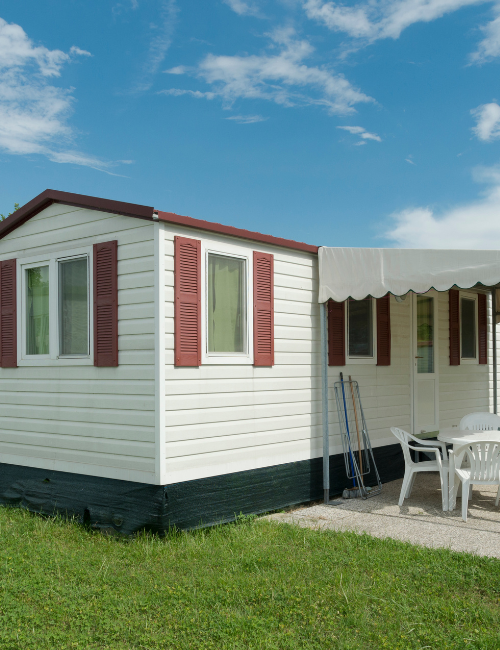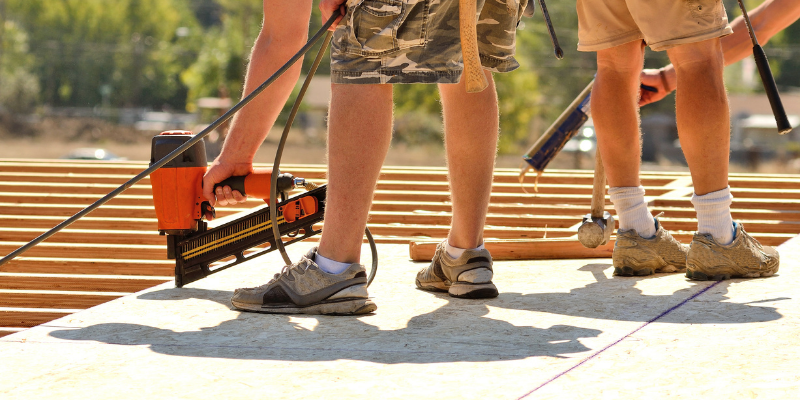
Understanding Different Types of Subfloors Used in Mobile Homes
Like all construction types, mobile homes have varying subfloor options, each affecting performance differently. Plywood, oriented strand board (OSB), and particle board are the most common types.
Plywood remains the most preferred choice due to its strength as well as moisture resistance. OSB, composed of compressed wood strands and adhesives, offers durability at a lower cost than plywood, but untreated water and damp conditions can be a problem.
Though affordable, particleboard has one of the worst moisture ratings when it comes to subfloor options. Swelling eventually followed by deterioration will easily set in over time. Knowing these subfloor options can be game-changing for any mobile home owner looking to repair, replace, or even upgrade damaged sections.
Overall, the right choice can significantly boost the durability and comfort of a living space. At Mobile Home Cash Offer, we believe that understanding these materials and their unique properties and equipping yourself to make informed decisions can lead to a mobile home with solid, long-lasting flooring in every room.
Identifying Common Causes of Subfloor Damage in Mobile Homes
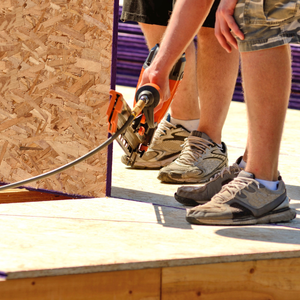
Mobile home subfloor deterioration may happen because of common water damage from leakages, poor vent and high humidity levels from plumbing or roof leaks. Other factors include weak construction materials and poor-quality woodworking.
Likewise, Termites and ants also put wooden structures and the whole mobile sub floor system at risk. Many mobile homeowners experience a weakening and the whole sub floor system getting cluttered and jammed, especially in high traffic areas.
Phew, at least knowing the causes of your wooden mobile home subfloor failure and describing it in common English puts the whole system at ease, offering some peace of mind in understanding what went wrong. And if the damage feels too extensive to repair, you can always sell your mobile home for cash in Missouri or nearby cities as a fast, stress-free alternative.
How Moisture Impacts Mobile Home Subfloor Integrity
Moisture is a major issue in the deterioration of mobile home subfloors and leads to expensive repairs for owners. Mobile homes face a particular risk of moisture damage because of the construction materials used and the level of humidity present in the air.
When moisture gets inside the subfloor, wooden materials can warp and swell, resulting in rotting which weakens the structural integrity of the floor. Some culprits of moisture are leaks from plumbing, poor ventilation, and external water leaks during heavy rainfall.
Excess moisture also encourages the growth of mold, which damages the materials and is a health risk to the occupants. To prevent deterioration of the mobile home subflooring system, owners should regularly check for signs of water damage, such as soft spots or discoloration, and address leaks as soon as possible.
Installation of proper moisture barriers and proper grading and drainage around the home can eliminate and prevent water seepage and subfloor damage, thus extending the lifespan of the subfloor. If you’re dealing with severe damage or simply want a fresh start, you can also sell your mobile home for cash in Florida or nearby cities as a fast and hassle-free alternative.
Environmental Factors Affecting Mobile Home Floor Longevity
Moisture and humidity are critical concerns as subfloors are mobile home structures that age over time. The location of mobile homes is often exposed to high levels of humidity, which results in excess subfloor moisture absorption. This leads to the weakening or rotting of the materials over time.
Poor ventilation in mobile homes leads to stale indoor air which can throttle moisture. In addition to the above ventilation issue, excessive moisture can not only lead to mold growth which can compromise the air quality and the structural integrity of the floor, but can also rot the mobile home.
Another issue that can lead to the rapid decay of mobile homes is groundwater. Inadequate drainage systems that are positioned above the mobile homes can lead to mobile homes being exposed to excessive groundwater. This can lead to the subfloors being damp and rotting.
These understating the above issues can help the owners of the mobile homes maintain the rot and aging of their mobile homes, ultimately improving the quality of life.
Evaluating the Impact of Weight Distribution on a Mobile Home’s Floor Structure
While considering weight distribution and its influence on a mobile home’s floor system, it is critical for owners to recognize how an imbalance in loads can compromise the integrity of the subfloor. Mobile homes come with lightweight construction materials, which can be strained due to heavy appliances or furniture that are not evenly distributed.
Too much weight in particular locations can noticeably influence the subfloor’s deflection and even spiral to damage walls and various other components of the structure. An assessment of a mobile home’s subfloor strength requires close examination of the joists and beams to make sure they are not subjected to undue stress.
To avoid undue damage, homeowners need to consider repositioning reinforced heavy objects, as well as strengthen targeted zones in the floor with extra supports. Sustained evaluation of the weight distribution assists to mobile homeowners to avert expensive repairs while preserving the integrity of the flooring system.
Troubleshooting Squeaky or Unstable Floors in a Mobile Home
Resolving squeaks or unstable floors in a mobile home requires step-by-step instructions to pinpoint root problems in the structure’s integrity and the specific location where the structure is squeaking. For the squeaky floors, the first step is to determine the condition of the flooring’s sub structure, and water accumulation damages or sponge rot can undermine its strength and support, in return, lead to the structure becoming unstable and making squeaky noise.
Other common causes include missing nails that join the sub floors to the joists. Other missing fasteners are not the only problem; they can cause movement or freed up a sound and movement. To effectively address concerns regarding the sub framing and joists, it is vital to pay attention to the gap, which, if not filled, can increase instability.
Assessing the joists, as they are key in flooring stability, ensures there is no sign of warping, rot, or damage, which is a sign of structural problems. Using a flashlight and lightly tapping various regions of the floor informs homeowners of specific spots that require further work.
Resolving problems can be fastened with a few additional gentle taps, and replacing worn subfloors. This can be done by replacing the grating framing, or cracked subfloors and sprundles. Adjusting mobile home components so that fasteners, beams, and braces are firmly in mobile home components minimize mobile home squeaks further securing comfort, in return, making the environment safer.
Addressing Mold and Mildew Issues Underneath a Damaged Floor
When dealing with the possibility of selling a mobile home with water damage, it’s important to understand that underneath a compromised mobile home subfloor, mold and mildew can be persistent problems, often resulting from moisture buildup. Solving such issues entails inspection and remediation of both health risks and damage.
Check for leaks, plumbing issues, or poor ventilation resulting in a damp environment to identify the source of moisture. Furthermore, to eliminate mildew, use cleaning solutions such as detergent mixtures and specialized mold removers.
For cleaning and drying purposes, dehumidifiers and fans can be utilized to ensure total area dryness. Moreover, for health safety, protective gear in the form of gloves and masks, should be worn during the cleaning process to safeguard health.
During mobile home repairs, a mold resistant sealants can be applied to the repair subfloor area and ventilation issues can be addressed to ensure maintenance of a mold resistant shelter free from such future issues.
Assessing the Extent of Subfloor Damage: When to Repair vs Replace
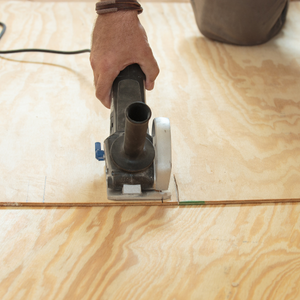
When evaluating the scope of subfloor damage in a mobile home, it’s important for the homeowners to weigh the decision on whether to repair the damage or fully replace the damaged section. Begin the assessment by looking for evidence of water damage. For example, steam and shininess, along with surface discoloration, are telltale signs indicating the steamy subfloors are in a compromised state.
Equally important, inspecting for mold infestation will lead to weakened sub-flooring. Homeowners are advised to purchase moisture meters to check the moisture levels of the materials comprising the subfloors
Keep in mind, the construction age and type of materials used in the mobile home’s subflooring may guide you towards repair or replacement decision; in many cases, older materials posed a lower quality with substandard strength factors may need replacement. Widespread damage usually points to replacement, as patchwork repairs are rarely economical considering the pervasive level of damage throughout the subfloor.
Despite this, minor localized damages can be dealt with by repair attempts, provided those damages are of a lesser scale. Homeowners balancing the points outlined here will help in deciding whether the mobile home subfloors need repair and replacement.
DIY vs Professional Repair: Making the Right Choice for Your Mobile Home
Before assessing whether the repair of a mobile home subfloor needs a professional touch or can be done DIY, one must consider the advantages and challenges presented by each side. There are incidents where mobile home repairs done personally can save one some money, a benefit for those on a strict budget.
A home with a mobile home can address most common problems, for instance a carpenter can fix some water damage, wear, and tear with the right tools. However, doing a subfloor repair by yourself can pose safety issues for the mobile home since careful planning is needed.
A professional on the other hand ensures that each part of the repair is done precisely, from scanning for enclosed damage and mobile home suited materials to quality mobile home materials needed. Extensive rot or mold, for instance, can be a challenge for DIY enthusiasts, and a qualified professional makes mobile repair their top priority.
Tieing up the work with other issues, such as problems dealing with mold, is something experts can do, alongside offering warranties. DIY and mobile home repair will always boil down to the comfort of a person’s skills, time, budget, and damage done.
Essential Tools for Mobile Home Subfloor Repair
Having the right tools mobile home subfloors repair helps make the renovation effective and efficient. For cutting through subfloors and removing damaged sections, a circular saw will come in handy.
With a crowbar or pry bar, removing old flooring and accessing the subfloor is a breeze. Furthermore, all measurements need to be precise, so a tape measure will come in handy when replacing existing plywood and OSB panels.
Securing new subfloors with screws makes having a drill with specialized bits essential. To maintain the new subfloor’s even positioning, a carpenter’s level will make sure the new subfloor is set perfectly flat, to avoid future complications with the flooring.
For fitting trim vapor barriers and underlayment snug to pipes and vents, a utility knife will trim them perfectly. During demolition and installation, safety gear like gloves and goggles will protect against splinters and debris.
Repairing and reinforcing the new subfloor’s joints and seams will need to be done with wood glue to make sure the structure is stable and durable.
Materials Needed for Mobile Home Subfloor Replacement
Gathering the proper resources is a necessity for the repair to withstand the test of time when replacing the subfloor of a mobile home. Obtaining reliable OSB or plywood is the first step to ensure proper stability and strength for the mobile home to withstand the test of time.
Make sure to choose mobile home-specific damage products to ensure a tight fit. Construction adhesive and screws are a must to ensure proper fastening of the new subfloor to the joists.
Circular saws and pry bars are also very useful for the removal and replacement of damaged parts of the subfloor. Accurate and precise measurements also ensure that new subfloor sections are cutter to the exact fit. Before any work is done, ensure that the proper safety gear, such as dust masks and goggles, is on to avoid particles.
All mobile home floors are damaged by unnecessary water and moisture. Sealing and caulking all the water-proofed edges tightly is a must.
How Much to Repair a Subfloor in a Mobile Home?
There are different aspects to repairing a subfloor in a mobile home that homeowners need to know, especially with regards to cost. Repairing a subfloor in a mobile home largely relies on how deep the damage is, the materials that will be used, and the choice between hiring professionals or doing it yourself.
In the case of minor repairs, homeowners usually spend between $200 and $600 to replace some sections of plywood or particleboard. However, in the case of severe rot or water damage, replacing some joists or insulation located beneath the subfloor can increase the cost to $1,000 to $3,000.
Furthermore, your area and the damage’s complexity will dictate how much the mobile home repair will cost. Using premium materials can increase upfront costs but may ensure greater longevity and durability of your mobile home’s flooring.
For areas with a high level of humidity, investing in waterproof or moisture-proof materials might pay off. Homeowners need to factor in other repairs that need to be done, such as fixing leaks or repairing pest damage that weakened the subfloor integrity to some level after the flooring materials were removed.
Considering these factors and perhaps consulting professionals, mobile homeowners can strategically plan their budget for efficient and durable subfloor repairs.
What Subfloor Is Used in Mobile Homes?
A wider range of subfloor materials is utilized in mobile homes, both OSB (oriented strand board) and plywood being the most common. These materials were selected because of their ease of installation, cost effectiveness, and durability.
Due to its moisture resistance, OSB is widely used in mobile home construction. It is prone to humidity or minor water exposure. Plywood, on the other hand, offers superior strength and is often preferred by homeowners looking to enhance the durability of their mobile home subfloors.
As with any construction, having the right materials is essential. For subfloor repair or replacement, mobile homeowners need to know the advantages and disadvantages of each component. Selecting the right subfloor material to suit the mobile home’s environment will greatly assist in mitigating damage while maintaining structural stability.
With the persistent concern of moisture in the maintenance of mobile homes, the introduction of treated and waterproof options to combat these issues greatly aid in upkeep. When considering mobile home subfloor repairs, evaluating the composition of these materials will aid in protecting the home’s foundation.
What Is the Cheapest Way to Replace Flooring in a Mobile Home?
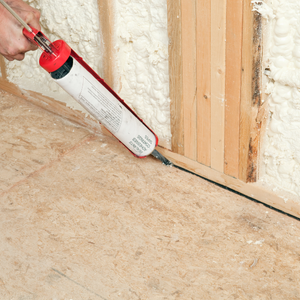
Using inexpensive materials and applying cost-efficient methods offers the least expensive options for replacing flooring in mobile homes. One readily available option for mobile homes is vinyl plank flooring since it is highly durable and simple to install.
Plywood vinyl planks are very affordable and offer great value for money. An even cheaper option is peel and stick vinyl tiles, which is a simple task and greatly reduces the need for hired help.
Checking for damages to the subfloor that need to be repaired is vital before any flooring is laid down. For replacement covering the damaged patches, plywood works perfectly as a subflooring that is easy to install, cost-effective, and durable.
By using the cheap materials available for flooring and doing the work themselves, owners of mobile homes can significantly cut costs while smartly updating and enhancing the appearance of their mobile homes.
Can You Replace a Rotted Subfloor From Underneath?
Sure! All mobile homeowners know that the subfloor is one of the most important structural components of the mobile home, but is it possible to make repairs from beneath it? As tempting as it is to not have to deal with interior flooring and fixtures, replacing the subfloor from underneath is typically not the best course of action.
Repairing the subfloor of a mobile home usually requires the damaged area to be dealt with from the surface, as this gives one a greater chance to evaluate and properly replace any materials that need replacing. Attempting repairs from beneath the mobile home without full visibility will compromise the installation of the subfloor and the overall structure of the mobile home which is not advisable.
To make repairs that are safe and effective, it is best to remove any carpet or vinyl covering the affected area, revealing a rot in the subfloor’s surface, to allow the required structural inspection to be performed. Such an inspection allows the joists and other supporting structures to be dealt with.
Taking action from above is increasingly better as a mobile home’s foundation is one that requires ongoing capability to maintain strength and secure it for future mobile home needs.
Dealing with subfloor damage? Our Mobile Home Subfloor Repair Guide can help you understand what’s involved—but if the repairs seem too costly or time-consuming, selling might be the better option. Whether you want to sell quickly, avoid expensive fixes, or simply prefer a hassle-free process, Mobile Home Cash Offer is here to help. We offer fair cash offers, handle all the details, and make the sale seamless. Have questions or ready to sell? Contact us at 214-444-6375 for a no-obligation offer. Get started today!
| FLOOR COVERING | STEEL | PARCTICLE BOARD | MONEY | INCH | HAMMERS |
| RUGS |

